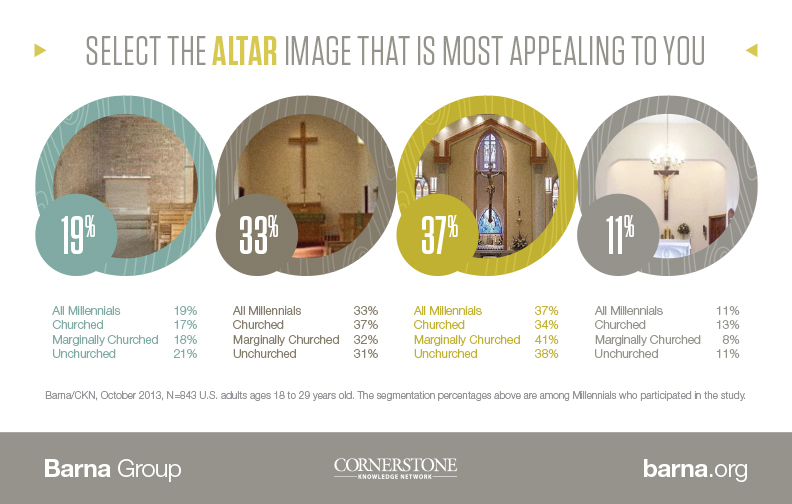
A little over a week ago we were talking about how more and more young Evangelicals prefer to participate in liturgical forms of worship. Now Barna has come out with a new study that tells us what kinds of buildings Millennials prefer to worship in. And there seems to be a definite lean towards more reverent concepts of sacred space than some might expect.
“Many churches today are explicitly constructed not to look and feel too much like a religious place,” Barna notes, “a stark contrast to the ancient cathedrals and churches of old—the very design of which was intended to help people experience the divine. How does this design shift impact worshipers?”
Let’s summarize some of their findings briefly. Most people rejected large auditorium style sanctuaries in favour of smaller sanctuaries. The vast majority prefer altars with large Christian symbols (like a cross or crucifix) as opposed to plain altar pieces. Most prefer stained-glass windows (of varying elaborate natures) to plain-glass.
In the end, the majority described their “ideal” church with these words:
Community (as opposed to Privacy)
Classic (as opposed to Trendy)
Casual (as opposed to Dignified)
Sanctuary (as opposed to Auditorium)
Quiet (as opposed to Loud)
Modern (as opposed to Traditional)
While ‘Sanctuary,’ ‘classic’ and ‘quiet’ are more often associated with traditional church buildings, less than half of survey respondents preferred the word ‘traditional’ over ‘modern,’” Barna explains, noting a bit of a “cognitive dissonance” here among young adults interviewed in the survey. “Many of them aspire to a more traditional church experience, in a beautiful building steeped in history and religious symbolism, but they are more at ease in a modern space that feels more familiar than mysterious.”
Barna’s Clint Jenkins notes that “it’s tempting to oversimplify the relationship between Millennials and sacred space,” as if they were looking only for that which is new and chic. But in reality, “most Millennials don’t look for a church facility that caters to the whims of pop culture. They want a community that calls them to deeper meaning.”
Deeper meaning. That’s what we talked about in our previous post on Evangelicals gone liturgical. “Grandeur hooked me,” Kelsey May explains, “but it wasn’t what made me stay…. The aesthetic of traditional churches appeals to me, but the substance behind it anchors me.”
Let’s make sure we offer that substance in every aspect of our church-life. Be it in liturgy or church architecture, the point is not to provide aesthetic experiences that are beautiful merely for their own sake: they are to draw us into a deeper and richer relationship with the Christ who calls us together.
See Barna’s summary of their sacred space study here.
———————
HT to Gene Veith for bringing this study to my attention.
Tags: architecture, auditorium, Barna group, church architecture, contemporary, Evangelicals, liturgy, millennials, sacred space, stained glass, traditional, Worship
One subject that is particularly dear to my heart is worship theology. As a bit of an amateur song/hymnwriter myself, I tend to pay particular attention to the “worship wars” which have divided large parts of Christendom, especially in my own Lutheran heritage.
One of the most frequent – and, frankly, often justified – criticisms of contemporary worship music (even when used in a liturgical framework) is that so many of the songs are theological weak or even plain wrong. In a discussion of the interpretation of Colossians 3:16, the author of Lutheran Hymn Revival (who, by the by, is a rather excellent poet) expressed his frustration that so many of the new songs the church now sings “do not have God’s Word dwelling richly in it so that we might teach and admonish each other.” I agreed with his sentiments, but continued, “I see this not so much a failing of a particular literary or musical style; it is rather the failure of the church to raise up theologically astute songwriters.” As the discussion moved to another post (Worship Wars: Bridging the Divide), he echoed my sentiments, wondering why Lutherans were failing to take up the challenge of composing new theologically strong music:
I know that every now and then we get a Presbyterian or Baptist who writes “Lord, ‘Tis Not That I Did Choose Thee,” or “My Hope is Built on Nothing Else,” or “In Christ Alone,” but what does it say of us today that we cannot put together music and hymnody that is better than all that? What has happened to us and what is our problem? Doesn’t this show a spiritual dearth among us?
I had no easy answers at the time. I still do not. But I have more hope that Lutherans are beginning to take up the challenge. Recently the Lutheran Church – Missouri Synod held its first ever Lutheran Songwriter’s Conference. Michael A. Schmid has an excellent reflection on the event in this month’s issue of WorshipConcord Journal. In his words, “the intent was to gather Lutheran songwriters, to encourage and equip them in their craft, to engage in substantive discussion about theology as it pertains to worship songwriting, and then to challenge them to apply their art to blessing the church with Lutheran worship songs.” Let us pray that this truly represents the first steps in a serious commitment to “commissioning and creatin… worship songs with authentic confessional theology.”
In the past decades, there have been few issues which have so split the Church as has that of worship. Traditionalists call for fealty to the historic liturgy, arguing that the form which has served the Church for so long is intrinsically good in and of itself. Its theological strength, and likewise the theological strength of hymns, stands in opposition to the frequent shallowness of contemporary worship songwriting and service patterns. Proponents of contemporary worship counter that their musical genres better meet members of our culture where they are, without alienating people unnecessarily – something traditional worship can undoubtedly do. As a companion who once accompanied me to my home church’s worship service (traditional, of course) afterwards confided to me, “I honestly kept thinking I was in the Church of Thor, what with all the chanting and ‘thee’s and ‘thou’s.” He had been unable to get past the surface appearance of the service to the Gospel message underneath; to him, that particular setting of the divine service had seemed no more relevant than did Norse mythology.
Of course, both sides make important points. Traditionalists rightly point out that our worship should not be shallow. Contemporary worship advocates are equally correct in reminding us that worship must be understandable to its participants. If each group would be willing to just quiet its pride for a moment and listen to the other, perhaps the debate would cease to be so venomous. And perhaps a more constructive approach to the discussion would be taken, where the benefits and drawbacks of each side were honestly weighed and considered… where the positive aspects of both sides would be adopted and the negative aspects diminished.
Some worship songwriters are attempting to do just that. Here, I want to identify two camps and their “new” approaches to worship music writing in particular. The first I shall call ‘rewriters’; the second has already been called by others ‘new hymnody’ or ‘modern hymn writing’.
‘Rewriters’ are distinguished by their practice of “rewriting” hymns. They keep the words but tend to fashion new musical settings for hymns. As Indelible Grace Music puts it, the goal is “not change for change’s sake, but to rekindle a love of hymns and invite many who never associate rich passion with hymns to actually read the words.” If I might state it in linguistic terminology, the songwriters ‘translate’ the songs into musical styles whose emotional connotations are better comprehensible to people today – people for whom traditional music styles represent another ‘language’ with which they are not familiar. The practice is not in actuality new; the church has always rewritten the music of hymns in every era. Every era, that is, except the current one. Rewriters are bringing back this great tradition to the Church. One other praiseworthy note? Rewriters are bringing back incredible hymns that in some cases have completely fallen out of use in the Church. For an example of rewriting, see Matthew Smith’s new musical version of Josiah Conder’s 1836 hymn “My Lord I Did Not Choose You”.
‘New Hymnody’ or ‘Modern Hymn Writing’ has similar sympathies with rewriters – and it’s not surprising therefore to find artists who fit both categories. New hymnody is the approach of songwriters who are attempting to write completely new pieces which reflect the theological richness of traditional hymns while utilizing contemporary literary and musical styles. Perhaps the most famous proponent of this genre is Keith Getty. Maintaining that “what we sing becomes the grammar of our belief,” Getty strives to write contemporary worship music that teaches us about our faith as much as it allows us to express that faith. Consider, for example, the theological depth of “In Christ Alone,” written by Keith Getty and Stuart Townsend. What traditionalist would consider this song ‘shallow’?
In Christ alone my hope is found;
He is my light, my strength, my song;
This cornerstone, this solid ground,
Firm through the fiercest drought and storm.
What heights of love, what depths of peace,
When fears are stilled, when strivings cease!
My comforter, my all in all –
Here in the love of Christ I stand.
In Christ alone, Who took on flesh,
Fullness of God in helpless babe!
This gift of love and righteousness,
Scorned by the ones He came to save.
Till on that cross as Jesus died,
The wrath of God was satisfied;
For ev’ry sin on Him was laid –
Here in the death of Christ I live.
There in the ground His body lay,
Light of the world by darkness slain;
Then bursting forth in glorious day,
Up from the grave He rose again!
And as He stands in victory,
Sin’s curse has lost its grip on me;
For I am His and He is mine –
Bought with the precious blood of Christ.
No guilt in life, no fear in death –
This is the pow’r of Christ in me;
From life’s first cry to final breath,
Jesus commands my destiny.
No pow’r of hell, no scheme of man,
Can ever pluck me from His hand;
Till he returns or calls me home –
Here in the pow’r of Christ I’ll stand.
As we seek to create worship resources for the current era, perhaps we will consider the sterling examples of rewriters and modern hymn writers. Or, I suppose, we could just continue arguing from both sides of the worship debate – arguing how hymns are intrinsically better or contemporary songs intrinsically more relevant. For surely that will bring about the Church unity Christ desires.
—-
For more information on the songwriters referenced above, please visit the following websites:
Indelible Grace Music
Matthew Smith
Getty Music
Tags: church, contemporary, division, hymn, hymnwriting, liturgical, modern, Music, new hymnody, rewriter, songwriting, theology, traditional, wars, Worship



